
Dustin Rudiger and Rafael Knittel

A lot of our daily practices are responsible for the release of greenhouse gases, particularly carbon dioxide, which warm the atmosphere. Over the last 50 years, the carbon dioxide level has increased from around 310 parts per million (ppm) to about an alarming 390 ppm as a result of events ranging from major changes such as our increase in industrialization to the increase in automobile usage in our daily life. If we put those statistics into a percentage of our overall carbon dioxide emissions over the past 250 years, we can see that it has increased more than 40%. However, it is not the carbon dioxide that causes the most damage to the ozone layer that protects our planet from the Sun’s ultraviolet radiation, but the gases that come hand in hand with our carbon dioxide emissions, such as the CFCs and the nitrous oxide we generate.
CFCs are one of the most hazardous gases for our ozone layer, and their accumulation in our atmosphere is known to be a leading cause of global warming. However, scientists have predicted that if CFCs become permanently banned, the ozone layer will return to its normal consistency and thickness. Global measures have been already taken to reduce CFC emissions, and some nations already drastically reduced their CFC emissions. CFCs originate from an attempt to replace ammonia as a refrigerant, and even thoughit ultimately accomplished its goal, their damage to the atmosphere was much greater than that of ammonia, especially due to their high level of infrared radiation absorption. CFCs, however, are not as abundant as other greenhouse gases, such as methane, which is predominantly emitted into the atmosphere by both leakage of waste and the gas emissions of domestic cattle. However, some greenhouse gases are actually beneficial for the ozone layer as a whole, but the damage done towards global warming is still an issue.
Some of these gases are ultimately responsible for an increased amount of trapped heat in the atmosphere, which ultimately leads to several global changing consequences. One of these is the increase in sea level, which over time can mean consequences such as an acceleration of coastal erosion, floods, loss of wetlands and even more damage from storms. This means that the emission of harmful greenhouse gases and their contribution to global warming over time can ultimately lead to a change in our global ecosystemas a whole. Increased temperatures also means that organisms that regulate their homeostasis based on temperature will have to adapt, leading to a domino effect that can go as far as to changing whole trophic levels and animal populations.
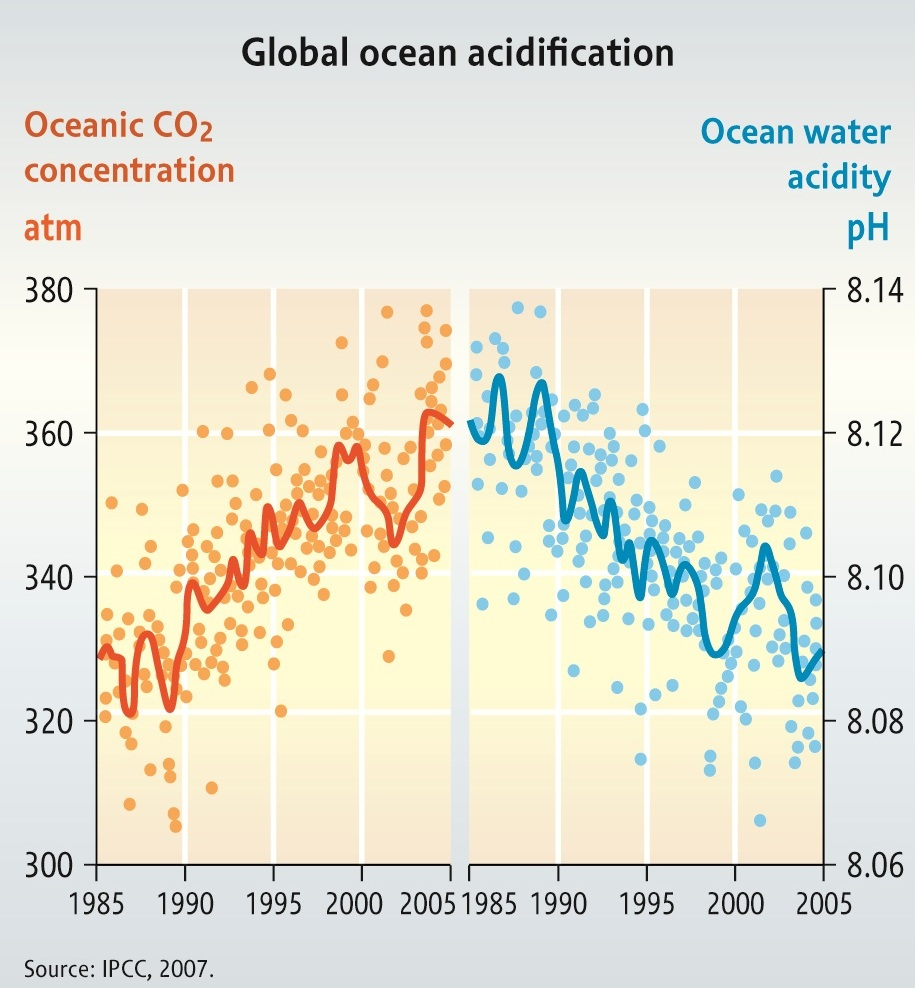
The increasing levels of carbon dioxide in the atmosphere result in higher levels in the ocean, as seen by the change over time of carbon dioxide and ocean pH and their negative correlation in the chart to the right. This causes a chain reaction where some of it forms carbonic acid, which then becomes bicarbonate acid, making the ocean more acidic. With the decrease in pH, calcifying organisms struggle to form shells. An example of these organisms can be seen in corals. The more acidic the ocean becomes, the harder it is for corals to maintain their calcified parts, meaning that the beauty of chains of corals such as the Great Barrier Reef could be soon lost due to ocean acidification. Studies have already shown that the growth rate of corals in the Great Barrier Reef has already decreased by around 15% in the last 20 years. However, the dangers of ocean acidification are far greater than what to some might seem to be just a lack of aesthetic beauty within the ocean.
The oceanic food web might become heavily impacted in the future due to the increasing levels of acidity. For example, it might be possible that Antarctic krill eggs wouldn’t be able to hatch, meaning that most, if not all, animals that inhabit the Antarctic region would have their diet affected due to the large impact in the overall food web of the area. Additionally, the internal processes of some animals are also impacted by ocean acidification, ranging from effects such as tissue damage in internal organs to failure to reproduce. It has been proven that shifts in ocean pH level have already wiped out entire species of sea life; therefore, ocean acidification is one of the most destructive effects of global warming on the marine ecosystem.
Over the last century, commercial fishing has increased exponentially, resulting in extinctions and the endangerment of many species. One of these can be seen below: the bluefin tuna. Overfishing has driven it to the endangered species list, yet commercial fisheries continue to catch it.
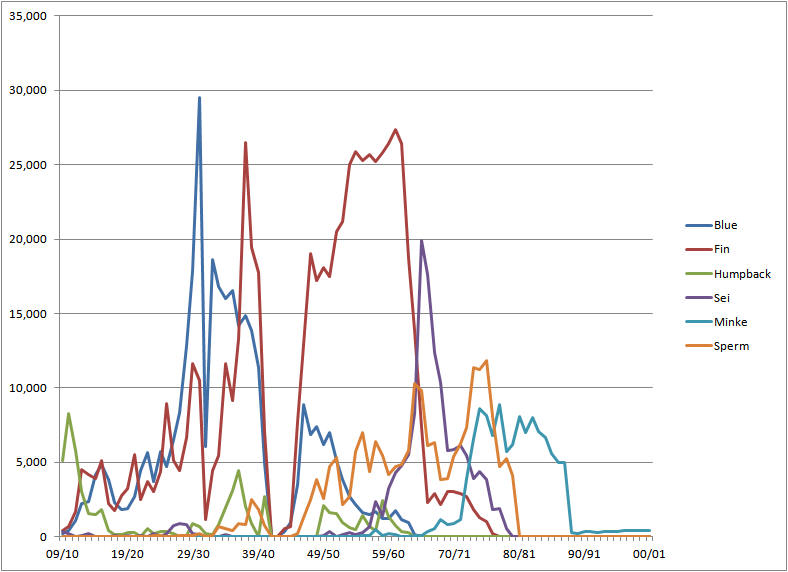
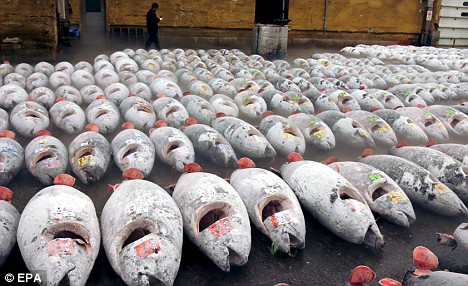 As yearly yields of certain species climb higher and higher, eventually the species cannot sustain its population anymore, and can collapse. This can be seen in the graph to the right, which shows the number of whales of each species harvested per year. Although this graph is affected by things such as WWII, the 1986 moratorium on whaling, and bans on certain species, it shows the general trend of increasing yields until the population collapses, bringing the yields down with it.
As yearly yields of certain species climb higher and higher, eventually the species cannot sustain its population anymore, and can collapse. This can be seen in the graph to the right, which shows the number of whales of each species harvested per year. Although this graph is affected by things such as WWII, the 1986 moratorium on whaling, and bans on certain species, it shows the general trend of increasing yields until the population collapses, bringing the yields down with it.
While these declines are already bad news for us since many communities rely on the yields they get from the ocean, and many of us enjoy eating seafood, it also has an adverse effect on global temperatures. Marine life provide an essential service in regulating the atmospheric temperature. The carbon dioxide warming the atmosphere makes its way into the food chain, and the excretions from marine life fall to the ocean’s floor as “marine snow”, sequestering the carbon dioxide in sediments. With the human-caused decline in these species, more carbon dioxide will remain in the atmosphere, and will contribute to global warming.
When solar energy reaches Earth, about a quarter of it is reflected off of the atmosphere, and about a quarter gets absorbed. Most of the rest of the energy is absorbed by the surface, but some of it is reflected. The reflectivity of the surface is known as the earth’s “albedo.” It ranges from 1 (perfect reflectivity) to 0 (no reflectivity). The average albedo of the earth is about .3, but the local albedos of areas with lots of ice and snow will be much higher. Open ocean has a relatively low albedo. The high albedo of arctic regions allows them to stay frozen over throughout the year, since much of the solar energy is reflected.
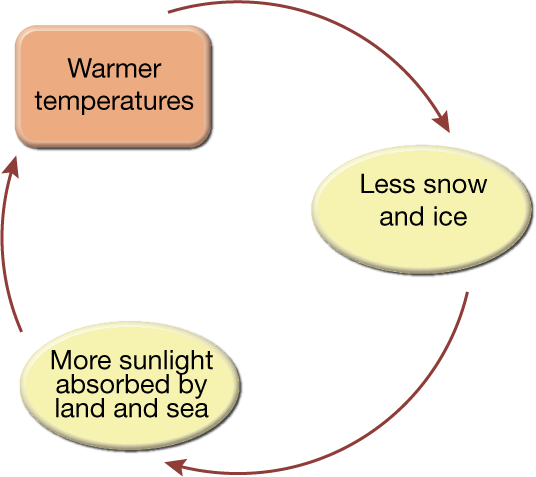
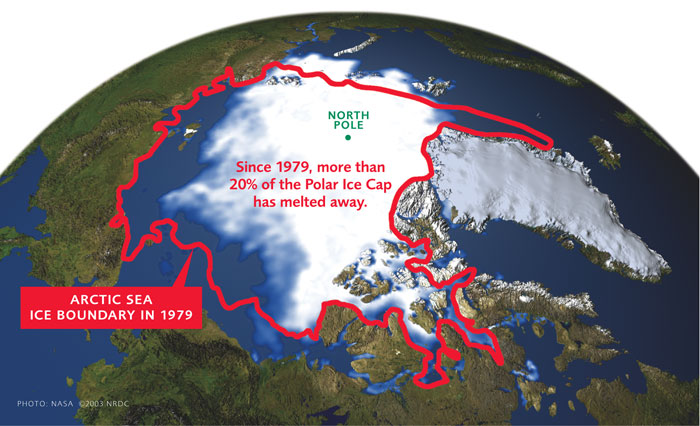
Unfortunately, rising global temperatures are melting a lot of the arctic ice, and this meltwater is substantially raising sea levels. This is in addition to the increase in sea levels caused by the expansion of the water due to higher ocean temperatures. With the melting of these ice sheets, more ocean water is being exposed, which, because of its low albedo, absorbs most of the solar radiation that reaches it. This raises the temperature of the arctic waters, which in turn melts more ice. This results in a vicious cycle, or positive feedback loop, as shown in the figure to the left. The drastic effects of this cycle can be seen in the picture to the right, which shows that since 1979, more than 20% of the polar ice cap has melted. With the meltwater increasing, many low-lying coastal regions will eventually sink into the sea, displacing millions of people.
This meltwater will also have an impact on ocean currents. One of the major currents in the Atlantic ocean is caused by warm, saline water flowing north from the equator. As it reaches the arctic regions, it cools, and its higher density causes it to sink to the bottom and travel south.
These currents are a vital part of the ocean ecosystems, since they exchange nutrients between surface waters and deep waters. However, the introduction of large quantities of low-salinity meltwater may dilute the saline waters flowing into the arctic, which would slow their descent, or possibly prevent them from sinking. This stratification could slow down the current, causing a reduction in the flow of nutrients to organisms throughout the ocean.
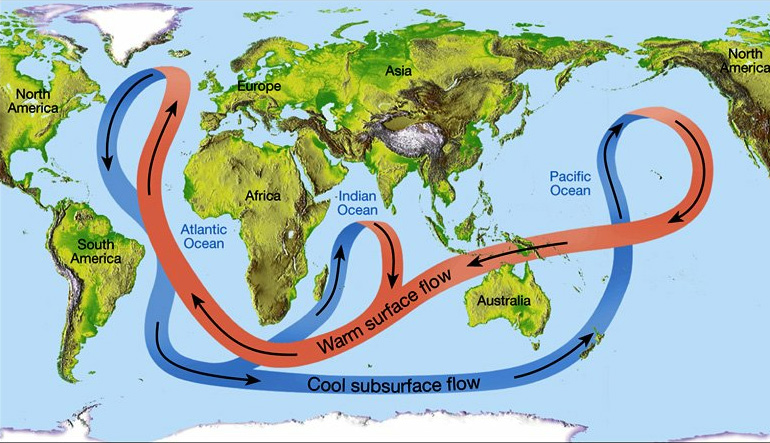
UCLA ESS 15 ocean/climate science communication project for Prof. Tripati in Fall 2014
Copyright Disclaimer: Pursuant to Section 107 of the Copyright Act of 1976, allowance is made for 'fair use' for purposes such as criticism, comment, news reporting, teaching, scholarship, and research. Fair use is a use permitted by copyright statute that might otherwise be infringing. Non-profit, educational or personal use tips the balance in favor of fair use.